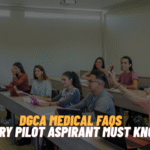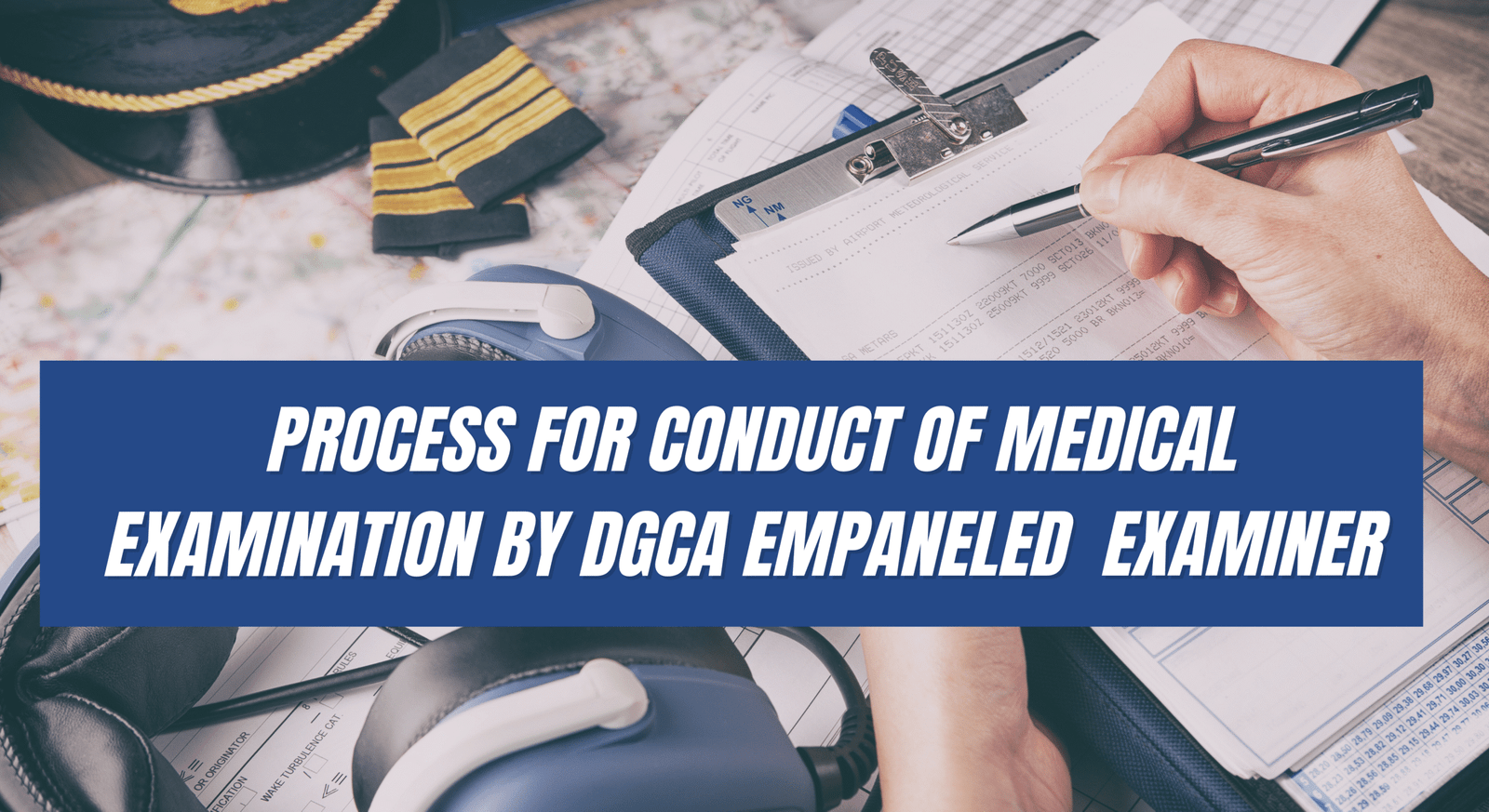
- The objectives and importance of DGCA medical examinations.
- Eligibility and scope of Class 1, 2, and 3 certifications.
- The step-by-step process flow followed by examiners.
- The forms and documentation involved.
- Roles and responsibilities of pilots, examiners, and DGCA assessors.
- The validation rules and best practices applicants should know.
Training Objectives
The medical examination module has four main objectives:- Identify the pre-requisites for issuance or renewal of a medical assessment.
- Define the end-to-end process for medical assessment.
- List the different sections of the medical form.
- Apply the validation and business rules that govern assessments.
Introduction to DGCA Medical Examinations
The Directorate of Medical is tasked with approving and issuing Class 1, 2, and 3 medical certifications for:- Pilot applicants
- Air Traffic Control Officers (ATCOs)
- Private Pilot’s License (Airplane/Helicopter)
- Student Pilot’s License (Airplane, Helicopter, Glider, Balloons, Microlights)
- Pilot’s License (Microlight)
- Flight Radio Telephone Operator’s License (FRTOL & FRTOL-R)
Process Flow: DGCA Medical Examination (9 Steps)
Every empanelled examiner follows a standard nine-step process on the eGCA portal:1. Examiner Login
- Examiner logs in with ID, password, and captcha.
- Applicants must have submitted and revalidated the application on the same day.
2. Search Application
- Examiner searches using eGCA ID or Application ID.
- Applicants must show appointment SMS/email and the registered ID proof.
3. Import Application
- Examiners import the application into their worklist.
- Only imported cases can proceed to assessment.
4. Verify Identification
- The examiner checks ID (Aadhaar, Passport, Driving License, etc.).
- The system confirms successful verification.
5. Re-Verify Application
- The examiner confirms that details match the applicant’s declarations.
- Same-day revalidation is mandatory.
6. Conduct Examination
Examination includes:- General medical exam: height, weight, blood pressure, heart, lungs.
- Eye exam: visual acuity, color vision, depth perception.
- ENT exam: ears, nose, throat, balance, hearing.
- Aviation medicine (optional): hypoxia, stress, altitude effects.
7. Medical Opinion
Examiner records result:- Fit
- Temporary Unfit
- Permanent Unfit
8. DGCA Review
- DMS-CA reviews the examiner’s opinion.
- DGCA confirms or updates status.
9. Status Update
- Final outcome appears under Medical Applications → Other tab.
- Applications expire after 30 days if not processed.
Forms Involved in DGCA Medical Examinations
When you undergo a DGCA medical examination, everything happens digitally on the eGCA portal. Both you (the applicant) and the examiner interact with a series of standardized forms. These forms make the process transparent, consistent, and easy to track. Here’s a breakdown of the forms and what each one is used for:| Form | Purpose | Filled by |
| Basic Details | Personal information (name, eGCA ID, ID proof) | Applicant |
| Medical Declaration | Health history, lifestyle habits | Applicant |
| Search Application | Finds application | Examiner |
| Verify Applications | Confirms applicant’s ID | Examiner |
| Medical Examination | Records general health check | Examiner |
| Eye Examination | Vision and color vision | Examiner |
| ENT Examination | Hearing and balance | Examiner |
| Aviation Medicine (optional) | Flying-specific checks | Examiner |
| Medical Opinion (CA-35) | Final fit/unfit status | Examiner & DGCA |
- As an applicant, you now know exactly what each form does and what to expect during your medical appointment.
- As an examiner, you get a structured workflow with no scope for skipping critical checks.
- As DGCA, this ensures uniformity and accuracy across all medical assessments.
Form Details: Introduction
Before we look at the individual medical forms, it’s essential to understand how the eGCA system handles information.- Shared Visibility
- All the details you (the applicant) submit during registration and medical declaration are automatically visible to the examiner assigned to conduct your medical exam.
- After the examiner records results and observations, these are in turn visible to DGCA officers who review and finalize your medical status.
- This ensures a chain of accountability — applicant → examiner → DGCA.
- No Hidden Information
- Nothing is hidden at any stage.
- Applicants, examiners, and DGCA officers all interact with the same digital record, making the system transparent and reliable.
- Digital e-Forms
- Every step of the medical process is documented in standardized electronic forms (e-forms).
- These forms replace paper records, reduce errors, and make the process more trackable.
- From basic details to the final “Fit/Unfit” opinion, everything is captured digitally.
Revalidation of Medical Application – A Critical Step
Before you meet the examiner on the day of your appointment, you must complete a step called revalidation on the eGCA portal.- What is revalidation? Revalidation is simply confirming that your application and medical declaration are up to date on the same day as your medical exam.
- Why is it important? Without revalidation, your application will not appear in the examiner’s worklist. This means your medical exam cannot proceed.
- How do you do it?
- Log in to the eGCA portal.
- Go to the Medical section.
- Select your application and click Revalidate.
- Once successful, you’ll see the message: “Your application has been validated successfully.”
- When should you do it? Always on the day of your medical appointment, before visiting the examiner.
Sections of the DGCA Medical Examination Form
When you meet a DGCA empanelled examiner for issuance or renewal of your medical certificate, the process is systematic and structured. The eGCA portal guides both applicant and examiner through specific sections of the medical form. Here’s what examiners see — and what applicants should expect.- History Details
- Past medical history, surgeries, and lifestyle habits (smoking, alcohol, etc.).
- Helps examiners identify any background risks.
- Basic Details
-
- Personal details such as name, eGCA ID, ID proof, and contact information.
- Confirms the correct applicant is being assessed.
- Medical Declaration
- Health declaration submitted online before the appointment.
- The examiner re-verifies it against applicant statements
- Investigation Reports
-
- Blood tests, ECGs, and other uploaded reports.
- Examiner reviews before continuing.
- Medical Examination
-
- General health: height, weight, blood pressure, heart, lungs, and vital signs.
- Eye Examination
-
- Vision, color perception, and depth perception.
- Critical for pilots and ATCOs.
- ENT Examination
-
- Checks ear, nose, and throat.
- Ensures hearing, balance, and communication are not impaired.
- Aviation Medicine (Optional)
-
- Specialized checks (e.g., oxygen tolerance, altitude effects).
- Required only in specific flagged cases.
- Medical Examination Opinion
-
- Fit – cleared for certification
- Temporary Unfit – needs follow-up or re-exam later
- Permanent Unfit – not eligible for aviation duties
- As an applicant, knowing these sections helps you prepare for the checks in advance (like carrying recent lab reports or eye test results).
- As an examiner, it ensures you don’t miss any critical step in the structured workflow.
- For DGCA, it guarantees standardization across all empanelled examiners.
Form Details: Introduction
Before diving into individual e-forms, here are some key points:
-
All information submitted by applicants is visible to medical examiners.
-
Any reports or records entered by examiners are also visible to DGCA officers.
-
The system ensures full transparency between applicant → examiner → DGCA.
In the next sections, we will review the different types of e-forms used in the DGCA medical examination process.
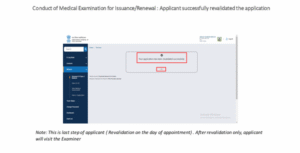
Why this rewrite works better:
-
Short, direct sentences (reduces reading grade level).
-
Converted vague language into clear bullet points.
-
Introduced keywords like DGCA medical examination process and e-forms.
-
Removed unnecessary filler like “In the following few screens” (since this is now web content, not slides).
Step 1: Examiner Login on eGCA
The first step in conducting a DGCA medical examination is for the empanelled examiner to log in to the eGCA portal.- Examiners use their unique eGCA ID and password to access the system.
- A captcha code is required to prevent automated logins.
- Once logged in, examiners can access the Medical Applications List, search for applicants, and begin the medical assessment process.
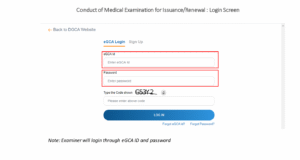
Step 2: Search Medical Application
After the applicant submits their medical application, the examiner must locate it on the eGCA portal.
Process for Examiners:-
-
Log in to the eGCA portal using examiner credentials.
-
From the Medical menu, click Search Medical Application.
-
Enter the applicant’s eGCA ID or Application ID.
-
Click Submit.
Important for Applicants:-
-
Carry your appointment SMS/email.
-
Bring the same ID proof used during registration; it will be needed for verification.
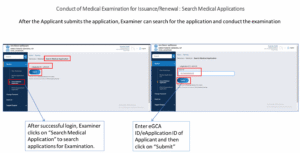
Step 3: Import Application
Once the application is found, the examiner must import it into their worklist before proceeding with the examination.
Process for Examiners:-
-
Select the correct application in the system.
-
Click Import Application.
-
Confirm by selecting OK in the prompt.
The application will now appear in the examiner’s Medical Applications List for further processing.
Rules and Best Practices for Importing Applications:-
-
Class 1 examiners: Can import Class 1, 2, and 3 medical applications.
-
Class 2 examiners: Can import only Class 2 applications.
-
Class 2 examiners with over 3 years of experience: May also import Class 3 applications.
-
Applications can be imported only if the applicant revalidates on the same day of the appointment.
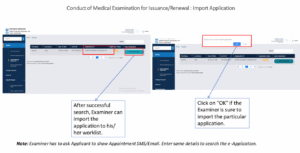
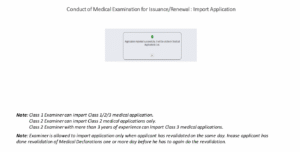
Step 4: Verification of Applicant Details
Once the application has been imported, the examiner must verify the applicant’s identity before proceeding with the medical exam. How Verification Works:- The examiner asks the applicant to provide the verification number.
- This number is the same as the ID used during registration (e.g., Aadhaar number, Passport number, Driving License number).
- The examiner enters this number into the system.
- Once validated, the application opens up and is ready for further processing.
- Always carry the same ID proof you used while registering in the eGCA portal.
- If your ID proof does not match, the examiner cannot proceed with your medical assessment.
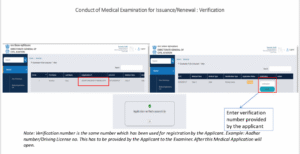
Step 5: Conducting the Medical Examination
After the applicant’s details have been verified, the examiner proceeds to conduct the actual medical examination through the eGCA portal. How Examiners Access Applications- The examiner clicks on the Medical Applications List tab.
- Applications that are ready for examination will show a status of “Pending with Examiner.”
- The examiner clicks View against the applicant’s case to re-verify the medical declaration and open the full application.
- Pending with the Examiner – The examiner needs to conduct the medical assessment.
- Approved – Medical assessment already finalized by DGCA.
- Declared Temporary Unfit – Applicant requires a re-exam after a specified period.
- Declared Permanent Unfit – Applicant permanently disqualified on medical grounds.
- Rejected by DGCA – Application has been rejected due to discrepancies or failure to comply.
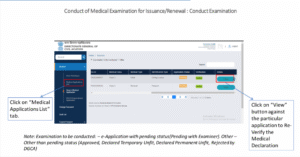
Step 6: Examiner Declaration and Re-Verification
After opening the applicant’s case from the Medical Applications List, the examiner must re-verify the applicant’s Medical Declaration. What Happens Here:- The examiner clicks on the Medical Declaration tab
- At the bottom of the page, they check the box for the Examiner Declaration.
- The examiner clicks “Re-Verify Medical Application.”
- A confirmation box appears — the examiner clicks OK to proceed.
- The system displays the message: “Medical Application has been successfully reverified.”
- If the examiner clicks Cancel Application, the application is updated with a Cancelled Status, and the applicant will need to reapply for medical.
- Re-verification ensures that the information provided by the applicant matches the identity proof and declarations on record.
Step 7: Examination Sections
The medical assessment is divided into five key sections, each focusing on different aspects of the applicant’s health. The examiner works through these sequentially on the eGCA portal:- Medical Examination
- General health check-up including height, weight, blood pressure, heart, lungs, and other vital parameters.
- Eye Examination
- Tests for visual acuity, color vision, and depth perception.
- Essential for pilots and ATCOs where vision accuracy is critical.
- ENT Examination
- Assesses the health of the ears, nose, and throat.
- Ensures hearing ability, balance, and communication are unaffected.
- Aviation Medicine Examination (optional)
- Specialized aviation-related checks such as oxygen tolerance, effects of altitude, and response to stress in aviation conditions.
- Used where needed or for specific cases flagged by DGCA.
- Medical Examination Opinion
- The examiner records the final status of the applicant’s fitness:
- Fit – Cleared for aviation duties.
- Temporary Unfit – Requires follow-up or re-exam after a set period.
- Permanent Unfit – Disqualified on medical grounds.
- The examiner records the final status of the applicant’s fitness:
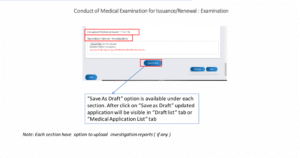
Step 8: Saving Progress and Uploading Reports
During the examination, the eGCA system provides flexibility to both examiners and applicants by allowing applications to be saved as drafts. Save as Draft Feature- Each section of the examination form (Medical, Eye, ENT, etc.) has a “Save As Draft” button.
- Examiners can save partially filled information, and the application will then be visible in either:
- the Draft List tab, or
- the Medical Application List tab.
- This prevents data loss and allows examiners to complete the process step-by-step.
- If an applicant has undergone any specialized medical tests (e.g., blood tests, X-rays, ECG, audiometry, etc.), the results can be uploaded directly under the relevant section.
- The system accepts common file formats (JPG, PNG, PDF, BMP) with size limits, ensuring smooth document submission.
- Specialized opinions from other doctors, if required, can also be attached.
- For Examiners: They can complete the process gradually and avoid errors.
- For Applicants: It ensures all relevant medical documents are on record, making the assessment transparent.
Step 9: Medical Examination Opinion (Final Submission)
Once all the examination sections have been completed, the examiner provides the final medical opinion. What the Examiner Does:- Marks the Application Status as one of the following:
- Fit – Applicant is medically cleared.
- Temporary Unfit – Applicant requires further evaluation after some time.
- Permanent Unfit – Applicant is disqualified on medical grounds.
- Adds Diagnosis (if any), remarks, and professional recommendations.
- Each section also allows recommendations; these are auto-carried into the Medical Examination Opinion screen.
- The examiner clicks Submit to finalize.
- Once submitted, the application moves to the Directorate of Medical Services (Civil Aviation) [DMS(CA)] for review.
- Recommendations and status get displayed in Form CA-35, the official medical assessment form.
- After submission, you cannot modify your application.
- Always ensure that all documents, test reports, and declarations are accurate before this step.
Step 10: Print Preview of Application
Before or after submission, the examiner has the option to preview the entire medical application.How It Works:
- At the end of the application form, the examiner clicks Preview.
- This displays all applicant details (basic details, medical history, test results, and medical opinion) in a consolidated format.
- The examiner can then:
- Print – Save the application as a PDF copy for record-keeping.
- Close – Go back to the form if corrections or further checks are needed.
- Ensures transparency by letting both examiner and applicant review the submitted details.
- Prevents errors before final submission to DGCA.
- Acts as a final audit trail for examiners, applicants, and DGCA officers.
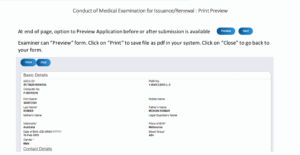
Step 11: Viewing Conducted Medical
Once the examiner submits the medical application, it is sent to DGCA for review. However, examiners can still access submitted applications in read-only mode for reference. How to View Conducted Medical- The examiner navigates to the Medical Applications List tab.
- Switches to Other under the filter option (instead of “Examination To Be Conducted”).
- This displays a list of applications that have already been conducted and submitted.
- By clicking View, the examiner can open the application in read-only format.
- Approved – Declared Fit by DGCA.
- Declared Temporary Unfit – DGCA has temporarily withheld clearance until further examination.
- Declared Permanent Unfit – DGCA has permanently disqualified the applicant on medical grounds.
- Pending – Application is still under review with DGCA.
- Rejected – Application rejected due to incomplete information or discrepancies.
- Provides examiners with a clear record of completed medicals.
- Allows DGCA to maintain transparency in decision-making.
- Ensures applicants can track their case progression consistently.
Step 12: Viewing CA-35 and Final Medical Assessment
Once the examiner has submitted the application and DGCA has reviewed it, the final outcome of the medical assessment is generated. How to Access It- The examiner (and applicant) can go to the Medical Applications List tab and switch to Other to see completed cases.
- By clicking View, the application opens in read-only mode.
- Under the Medical Examination Opinion section, the final decision is displayed.
- Fit – Applicants can download the official Medical Certificate (CA-35).
- Temporary Unfit – Applicants placed in the Temporary Unfit category may, depending on the circumstances, need to complete further medical tests and submit a fresh application after the prescribed period.
- Permanent Unfit – Applicant receives an Unfitness Letter, disqualifying them on medical grounds.
- Pending – Still under DGCA review.
- For Applicants – This is the official outcome of your medical clearance, a prerequisite for license issuance or renewal.
- For Examiners – Provides a clear closure to the assessment process.
- For DGCA – Ensures all cases are formally documented and traceable.
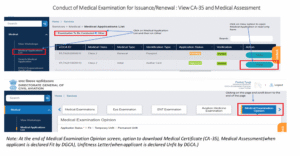
Conduct of Medical Examination by DGCA Empanelled Examiner
Roles and Responsibilities in the DGCA Medical Examination
The DGCA medical assessment process involves three main stakeholders, each with specific responsibilities to ensure the process is smooth, transparent, and compliant with aviation safety standards.Pilot (Applicant)
- Submits a request for medical assessment to the Directorate of Medical Services (DMS).
- Visits medical centers or empanelled examiners to undergo the medical examination.
Medical Center / Examiner
- Views medical applications submitted by applicants.
- Verifies applicant details and cross-checks ID proof against the system.
- Conducts and completes the medical examination, including all required sections (General, Eye, ENT, Aviation Medicine if applicable).
- Issues the medical certificate after successful examination, subject to DGCA’s final review.
Medical Assessor (DGCA Official)
- Reviews medical applications submitted by examiners.
- Completes the final medical request validation.
- Renews or denies the medical assessment based on the results and supporting evidence.
- The Pilot initiates and participates actively in the process.
- The Medical Examiner/Center ensures accurate, honest, and complete reporting.
- The DGCA Medical Assessor ensures uniformity and compliance across all applications, making the final call.
Validation and Business Rules for DGCA Medical Applications
To maintain standardization and transparency, DGCA has defined a set of validation and business rules for medical examinations. Both examiners and applicants must comply with these to ensure smooth processing.Key Rules:
- Search Restrictions
- An examiner can search the e-application using the eGCA ID or eApplication ID.
- Only one search is allowed at a time.
- Rotation of Examiners
- An examiner cannot examine the same pilot consecutively.
- For example, if Examiner A conducts the assessment this year, they cannot re-examine the same pilot for the next two years.
- The same examiner is only allowed again in the fourth year.
- Validity of e-Application ID
- An e-application ID is valid for 30 days from the date of submission.
- If the medical assessment is not completed within this time, the application is auto-rejected.
- Revalidation Rules
- If an applicant revalidates their application a day or more before the appointment, the system will prompt: “Applicant has revalidated earlier, please revalidate again on the day of medical.”
- Applicants must revalidate on the actual day of examination for it to be accepted.
- Medical Parameter Alerts
- If any medical parameters are outside the specified range, the field is highlighted in red.
- Examiners marking a parameter as abnormal must also highlight it in red for DGCA’s review.
Support and Assistance
If applicants or examiners face difficulties while using the eGCA portal or during the medical application process, DGCA provides dedicated support. Helpline Contact Details- Toll-Free Number: 1800-11-3422
- Email: egcasupport@dgca.nic.in

Raise a Support Request
- Users can log into the eGCA portal and navigate to the Support Request section.
- This allows applicants and examiners to raise technical or process-related queries directly through the system.
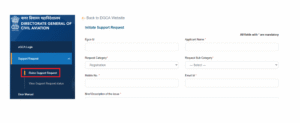 Troubleshoot options
Troubleshoot options
- In case of network loss or application taking too much time to load, then “Refresh” the application.
- At the time of “Search”, the Application ID or eGCAID should not contain space.
- If the DMS(CA)/Medical Assessor wants some re-examination for a particular section(Medical/Eye/ENT/Aviation Medicine), they will “Send Back” to the examiner.

